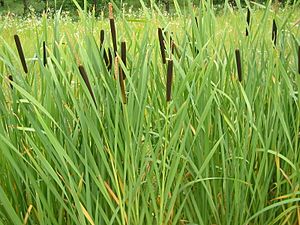List of monocotyledons of Montana facts for kids
Have you ever noticed that some plants look very different from others, even though they are all plants? Well, scientists group flowering plants into two main types: monocots and dicots. These names come from how many "seed-leaves" (called cotyledons) a plant seedling has when it first sprouts. Monocots usually have just one seed-leaf, while dicots have two.
There are between 50,000 and 60,000 different kinds of monocot plants around the world! In Montana, you can find at least 615 different monocot species. Some of these are even considered "Species of Concern" by the Montana Natural Heritage Program, meaning they need special attention to protect them.
Monocots are super important for us. A lot of the food we eat comes from them. Think about all the grains like rice, wheat, and maize (corn) – these are all monocots! The grass family, called Poaceae, is the most important group of monocots for our economy. This family also includes sugar cane and bamboo. Other useful monocots include the palm family (Arecaceae), banana family (Musaceae), ginger family (Zingiberaceae), and the onion family (Alliaceae), which gives us yummy onions and garlic.
Contents
Understanding Monocots
Monocots have some special features that make them different from dicots. Besides having one seed-leaf, their leaves often have veins that run parallel to each other, like stripes. If you look closely at a grass blade, you'll see this pattern. Their flowers also tend to have parts in groups of three or multiples of three.
Why Monocots are Important
Monocots are a huge part of our planet's plant life and our daily lives. They provide most of the food for people and animals. Imagine a world without rice, wheat, or corn – it would be very different! They also give us materials like bamboo for building and sugar for sweet treats.
Amazing Monocot Families
Let's explore some cool monocot families you might know!
Grasses
The grass family (Poaceae) is probably the most important monocot group. They are super good at being pollinated by the wind. This means they don't need bright, showy flowers to attract insects. Instead, their flowers are small and often gathered in fluffy plumes.
Here are just a few examples of grasses you might recognize:
- Common barley, Hordeum vulgare
- Bermudagrass, Cynodon dactylon
- Blue grama, Bouteloua gracilis
- Cheatgrass, Bromus tectorum
- Cultivated oat, Avena sativa
- Kentucky bluegrass, Poa pratensis
- Rice cutgrass, Leersia oryzoides
- Sugar cane, Saccharum officinarum (not listed in original text, but relevant to the intro)
- Wheat, Triticum aestivum
Orchids
The Orchidaceae family is the largest family of all flowering plants, with over 20,000 species! Orchids are famous for their beautiful and often complex flowers. They can be found all over the world, from tropical rainforests to cold mountains.
Some orchids found in Montana include:
- Fairy slipper, Calypso bulbosa
- Mountain lady's-slipper, Cypripedium montanum
- Hooded ladies'-tresses, Spiranthes romanzoffiana
- White bog orchid, Platanthera dilatata
Lilies
The Liliaceae family includes many well-known and beautiful flowers. They often grow from bulbs and have showy, six-petaled flowers.
Some lilies you might see:
- Beargrass, Xerophyllum tenax
- Chives, Allium schoenoprasum
- Columbia lily, Lilium columbianum
- Glacier lily, Erythronium grandiflorum
- Nodding onion, Allium cernuum
- Wood lily, Lilium philadelphicum
Cattails
You've probably seen cattails (Typhaceae) growing in wet, marshy areas. They have tall, stiff stems topped with a distinctive brown, sausage-shaped flower head.
- Broadleaf cattail, Typha latifolia
- Narrow-leaved cattail, Typha angustifolia


